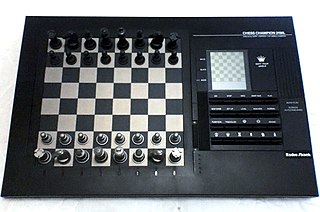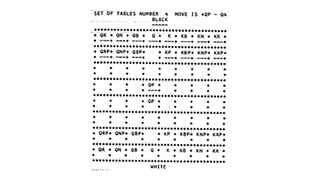Related Research Articles

Deep Blue was a chess-playing expert system run on a unique purpose-built IBM supercomputer. It was the first computer to win a game, and the first to win a match, against a reigning world champion under regular time controls. Development began in 1985 at Carnegie Mellon University under the name ChipTest. It then moved to IBM, where it was first renamed Deep Thought, then again in 1989 to Deep Blue. It first played world champion Garry Kasparov in a six-game match in 1996, where it lost four games to two. It was upgraded in 1997 and in a six-game re-match, it defeated Kasparov by winning two games and drawing three. Deep Blue's victory is considered a milestone in the history of artificial intelligence and has been the subject of several books and films.

Computer chess includes both hardware and software capable of playing chess. Computer chess provides opportunities for players to practice even in the absence of human opponents, and also provides opportunities for analysis, entertainment and training. Computer chess applications that play at the level of a chess grandmaster or higher are available on hardware from supercomputers to smart phones. Standalone chess-playing machines are also available. Stockfish, Leela Chess Zero, GNU Chess, Fruit, and other free open source applications are available for various platforms.

Raymond Dennis Keene is an English chess grandmaster, a FIDE International Arbiter, a chess organiser, and a journalist and author. He won the British Chess Championship in 1971 and was the first player from England to earn a Grandmaster norm, in 1974. In 1976, he became the second Englishman to be awarded the Grandmaster title, and he was the second British chess player to beat an incumbent World Chess Champion. He represented England in eight Chess Olympiads.

HIARCS is a proprietary UCI chess engine developed by Mark Uniacke. Its name is an acronym standing for higher intelligence auto-response chess system. Because Hiarcs is written portable in C, it is available on multiple platforms such as Pocket PC, Palm OS, PDAs, iOS, Microsoft Windows and Mac OS X.

David Neil Laurence Levy is an International Master of chess who plays for Scotland, and a businessman. He is noted for his involvement with computer chess and artificial intelligence, and as the founder of the Computer Olympiads and the Mind Sports Olympiads. He has written more than 40 books on chess and computers.
World Computer Chess Championship (WCCC) is an event held periodically since 1974 where computer chess engines compete against each other. The event is organized by the International Computer Games Association. It is often held in conjunction with the World Computer Speed Chess Championship and the Computer Olympiad, a collection of computer tournaments for other board games. Instead of using engine protocols, the games are played on physical boards by human operators.

Larry Melvyn Evans was an American chess player, author, and journalist who received the FIDE title of Grandmaster (GM) in 1957. He won or shared the U.S. Chess Championship five times and the U.S. Open Chess Championship four times. He wrote a long-running syndicated chess column and wrote or co-wrote more than twenty books on chess.

Sargon is a line of chess-playing software for personal computers. The original SARGON from 1978 was written in assembly language by Dan and Kathleen "Kathe" Spracklen for the Z80-based Wavemate Jupiter II.
Georgy Maximovich Adelson-Velsky was a Soviet and Israeli mathematician and computer scientist.

Belle is a chess computer that was developed by Joe Condon (hardware) and Ken Thompson (software) at Bell Labs. In 1983, it was the first machine to achieve master-level play, with a USCF rating of 2250. It won the ACM North American Computer Chess Championship five times and the 1980 World Computer Chess Championship. It was the first system to win using specialized chess hardware.

Microchess, sometimes written as MicroChess, is a chess program developed for the MOS Technology KIM-1 microcomputer by Peter R. Jennings in 1976, and published by his company Micro-Ware. The game plays chess against the human player at a beginner level, with the player entering moves via a keyboard and the computer responding, both in a custom chess notation. The game was ported to many other microcomputers such as the TRS-80, Apple II, Commodore PET and Atari 8-bit family computers by Micro-Ware and its successor company Personal Software between 1976 and 1980, with later versions featuring graphics and more levels of play. A dedicated hardware version of the game called ChessMate was produced by Commodore International in 1978, and the game's engine was licensed to Novag for its dedicated Chess Champion Mk II chess computer in 1979.

Kotok-McCarthy also known as A Chess Playing Program for the IBM 7090 Computer was the first computer program to play chess convincingly. It is also remembered because it played in and lost the first chess match between two computer programs. A pseudocode of the program is in Figure 11.15 of.
Kaissa was a chess program developed in the Soviet Union in the 1960s. It was named so after Caissa, the goddess of chess. Kaissa became the first world computer chess champion in 1974 in Stockholm.

Michael Francis Stean is an English chess grandmaster, an author of chess books and a tax accountant.
This article documents the progress of significant human–computer chess matches.
Events in chess in 1971;

Viktor Lvovich Korchnoi was a Soviet and Swiss chess grandmaster (GM) and chess writer. He is considered one of the strongest players never to have become World Chess Champion.

Computer Othello refers to computer architecture encompassing computer hardware and computer software capable of playing the game of Othello. It was notably included in Microsoft Windows from 1.0 to XP, where it is simply known as Reversi.

Sargon II is a sequel to Sargon. Both are computer chess programs for home computers.
The history of chess began nearly 1500 years ago, and over the past century and a half the game has changed drastically. No technology or strategy, however, has changed chess as much as the introduction of chess engines. Despite only coming into existence within the previous 70 years, the introduction of chess engines has molded and defined how top chess is played today.
References
- 1 2 Jennings, Peter (January 1978). "The Second World Computer Chess Championships". BYTE. p. 108. Retrieved 17 October 2013.
- 1 2 Hapgood, Fred (23–30 December 1982). "Computer chess bad-human chess worse". New Scientist. pp. 827–830. Retrieved 22 January 2015.
- ↑ Wheland, Norman D. (October 1978). "A Computer Chess Tutorial". BYTE. p. 168. Retrieved 17 October 2013.
- 1 2 Douglas, John R (January 1979). "Grandmaster Walter Browne versus Chess 4.6". BYTE. p. 110. Retrieved 17 October 2013.
- 1 2 Douglas, J R (December 1978). "Chess 4.7 versus David Levy". BYTE. p. 84. Retrieved 17 October 2013.
- ↑ Mather, Ian, The great computer chess bet, The Observer 20 August 1978
- ↑ David Levy, "Man Beats Machine!", Chess Life & Review , November 1978, pp. 600-03, at pp. 601-03.
- ↑ David Levy and Monroe Newborn, More Chess and Computers: The Microcomputer Revolution, The Challenge Match, Computer Science Press, Potomac, Maryland, and Batsford, London, 1980, pp. 10-30. ISBN 0-914894-07-2.
- ↑ David Levy, "Man Beats Machine!", Chess Life & Review , November 1978, pp. 600-03, at pp. 602-03.
- ↑ David Levy and Monroe Newborn, More Chess and Computers: The Microcomputer Revolution, The Challenge Match, Computer Science Press, Potomac, Maryland, and Batsford, London, 1980, p. 30. ISBN 0-914894-07-2.
- ↑ David Levy and Monroe Newborn, More Chess and Computers: The Microcomputer Revolution, The Challenge Match, Computer Science Press, Potomac, Maryland, and Batsford, London, 1980, Preface. ISBN 0-914894-07-2.
- ↑ "Tiny Computer Sends Chess Foe Down Tube". Milwaukee Journal. Washington Post Service. 1978-12-10. pp. Discover 1. Retrieved 21 January 2015.
- ↑ Frey, Peter W; Atkin, Larry R (October 1978). "Creating a Chess Player / An Essay on Human and Computer Chess Skill". BYTE. p. 182. Retrieved 17 October 2013.
- ↑ Frey, Peter W; Atkin, Larry R (November 1978). "Creating a Chess Player Part 2: Chess 0.5". BYTE. p. 162. Retrieved 17 October 2013.
- ↑ Atkin, Larry R; Frey, Peter W (December 1978). "Creating a Chess Player Part 3: Chess 0.5 (continued)". BYTE. p. 140. Retrieved 17 October 2013.
- ↑ Frey, Peter W; Atkin, Larry R (January 1979). "Creating a Chess Player / Part 4: Strategy in Computer Chess". BYTE. p. 120. Retrieved 17 October 2013.
- ↑ "Explore the Frontiers of Intelligence". BYTE (advertisement). December 1982. p. 99. Retrieved 6 February 2015.
- "Chess Skill in Man and Machine", Chess 4.5 - The Northwestern University Chess Program, L. Atkin & D. Slate, pp. 82–118, Springer-Verlag, 1977 - devotes a chapter to the history and internals of Chess 4.5
- reprinted in "Computer Chess Compendium", Chess 4.5 - The Northwestern University Chess Program, L. Atkin & D. Slate, pp. 80–103, Springer-Verlag, 1988,